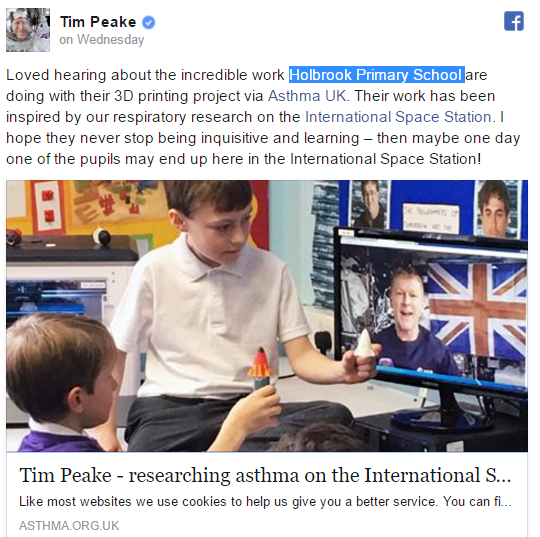
While they were inspired to make a medical device more fun to use and hold onto with a 3D printed, colorful cap, the young students at Holbrook Primary took their cue from an astronaut. Fortunate enough to be attending a school with a focus on STEM learning and a 3D printer as well, they integrated all of their ideas and new design talent—as well as the typical children’s adulation for space travel—and came up with a cool design that indeed caught the attention of British astronaut Tim Peake, who just happened to find out about their project all the way from the International Space Station. This type of attention should be a great indicator that your project is a winner—after all, not many kids are woken up early in the morning with positive remarks on a school project sent directly to them from space. At that age, most of us are happy with a star, a smiley face, or maybe a piece of candy from the teacher if we’ve been truly amazing.
“Loved hearing about the incredible work Holbrook Primary School are doing with their 3D printing project via Asthma UK,” said Peake. “Their work has been inspired by our respiratory research on the International Space Station.
“I hope they never stop being inquisitive and learning – then maybe one day one of the pupils may end up here in the International Space Station!”
The students had been following a respiratory study that Peake is involved in from the ISS, examining what is a pretty fascinating subject—the human lungs in space. His work has involved studying the respiratory system, and includes testing his lung capacity both in space and on Earth. The class was inspired by his work to make a very relevant item, for their age group as well as in regards to Peak’s study.
Another layer to the story involves the school’s current hopes for a grant by way of the European Space Agency, and while achieving that is a goal that the school and students would love to see happen, they were motivated to complete the project no matter what.
Williams is also the teacher for this particular class, and says that students Tristan Mann and Jack Bartum worked together to create the rocket topper which was featured on Asthma UK, a charity associated with asthma which actually visited the school and posted information about their project.“We had an idea for a project because we have had our 3D printer now for more than a year-and-a-half,” explained Richard Williams, the school’s computing coordinator. “We heard about some grants from the European Space Agency linked to Tim Peake’s mission to the International Space Station.
“We decided we were going to do it whether we got the grant or not. Every class has linked in 3D printing to their lessons.”
“When teacher Richard Williams told us about their 3D printing project we had to find out more!” states the Asthma UK team in their blog. “His Year 5 class were given the challenge of designing something that could fit on a standard asthma inhaler that would help children use them more easily. The designs have been stored on an online database and can be printed anywhere in the world, but not only that – they could even be printed in space!”
The information from Asthma UK was what grabbed Peake’s attention originally, spurring him on to both re-tweet the message and post it on Facebook as well.
“I heard lots of children were woken up early by their parents so they could be shown the message,” said Williams. “Our children have felt a part of that (Tim Peake’s research) by being involved in some of that work. They are so excited and interested to know about Tim Peake.”
Tristan and Jack worked hard on the rocket cap, making a digital design and 3D printing it after paring down their original concept for the whole inhaler piece to resemble a rocket.
“Both boys are quite quiet and calm but the design and the work they have done is great,” says Williams.
It’s really quite impressive to see such young students making their own designs and then bringing them to fruition with something like this topper, which could actually function as a very marketable—and utilitarian—item. According to Williams, every child in the school has had the opportunity to use the 3D printer, with other projects related to space, such as models of the ISS.
While the push in the US is very strong for the science, technology, engineering, and mathematics curriculum, it’s certainly emphasized very impressively around the rest of the world too—which should allow for a very interesting meeting of the minds as these brilliant and inspired children graduate one day and embark on careers that have the potential to carry them around the globe, demonstrating the skillsets they began refining so early on. What a great experience for these students. Discuss further in the 3D Printed Inhaler Cap forum over at 3DPB.com.
[Source: Ipswich Star]